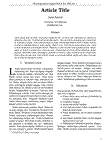Resultados de búsqueda - ( model OR (( modelr OR modeler ) OR modelado ))*
Materias dentro de su búsqueda.
Materias dentro de su búsqueda.
- 17
- México 11
- Innovación 9
- Technology 7
- Tecnología 7
- innovación 7
- Democracy 6
- Innovation 6
- Mexico 6
- Capacitación 5
- Creatividad 5
- Democracia 5
- M12 5
- communication 5
- comunicación 5
- Capital Humano 4
- Eficiencia 4
- Modelo 4
- Pymes 4
- SMEs 4
- Software 4
- Training 4
- educación 4
- education 4
- gender 4
- innovation 4
- quality 4
- C15 3
- C22 3
- C51 3
-
81
Revisión de los principales modelos de diseño instruccional (Review of main instruccional design models)
Publicado 2011“…A taxonomy of ID models is useful because it allows to identify and to analyze in a more expeditious way each model and help us to consider which can be more useful in the application in different situation. …”
Enlace del recurso
Artículo -
82
Cell death effect of CD47-agonist peptides on different types of leukemia and in a murine model
Publicado 2018“…Moreover, the immunogenicity of cell death was evaluated by calreticulin (CTR) exposure, ATP and DAMPs release (HSP70, HSP90, HMGB1, calreticulin). In and in vivo model, tumor volume, survival, cell blood count and tumor histology and immunochemistry (IHC) were assessed, at the same time, administration of a prophylactic antitumor vaccination, and determination of immunologic memory were performed. …”
Enlace del recurso
Tesis -
83
Artificial neural network modeling of phenol adsorption onto barley husks activated carbon in an airlift reactor
Publicado 2013“…The experimental data from the batch phenol adsorption onto barley husks activated carbon (BHAC) was represented by adsorption isotherms (Langmuir and Freundlich) and kinetic models (pseudo-first and pseudosecond order, and intraparticle diffusion models), besides the regeneration of phenolloaded BHAC with different solvents was evaluated. …”
Enlace del recurso
Tesis -
84
Using modelling approaches to understand the implications of physiological challenges and raw material demands on aquaculture feed designs
Publicado 2010“…Using modelling approaches to understand the implications of physiological challenges and raw material demands on aquaculture feed designs…”
Enlace del recurso
Artículo -
85
Developing Nutritional Models for Aquaculture: Integrating Existing Knowledge, Addressing Real Issues, and Setting Directions for Research
Publicado 2008“…Developing Nutritional Models for Aquaculture: Integrating Existing Knowledge, Addressing Real Issues, and Setting Directions for Research…”
Enlace del recurso
Artículo -
86
Modelando crecimiento y rentabilidad empresarial de la industria de Coahuila: Modeling Business Growth and Profitability in the Coahuila Industry
Publicado 2023“…Modeling Business Growth and Profitability in the Coahuila Industry: Modelando crecimiento y rentabilidad empresarial de la industria de Coahuila…”
Enlace del recurso
Artículo -
87
Mathematical Modeling of a Transient Vibration Control Strategy Using a Switchable Mass Stiffness Compound System
Publicado 2014“…The semiactive control strategy is applied in a piecewise linear compound model and involves an on-off logic to connect and disconnect a secondary mass stiffness system from the primary isolation device, with the aim of providing high energy dissipation for lightly damped systems. …”
Enlace del recurso
Artículo -
88
-
89
Successful pharmaceutical-grade streptozotocin (STZ)-induced hyperglycemia in a conscious tethered baboon (Papio hamadryas) model
Publicado 2015“…Background Non-human primate (NHP) diabetic models using chemical ablation of b-cells with STZ have been achieved by several research groups. …”
Enlace del recurso
Artículo -
90
Word-of-mouth intent in the restaurant industry of Mexico, a structural equation modeling approach mediated by customer satisfaction
Publicado 2022“…Partial least squares- structural equation modeling was the chosen approach to test hypotheses. …”
Enlace del recurso
Artículo -
91
-
92
-
93
-
94
Word-of-mouth intent in the restaurant industry of Mexico, a structural equation modeling approach mediated by customer satisfaction.
Publicado 2022Materias: “…structural equation modelling…”
Enlace del recurso
Artículo -
95
Modelo estructural para evaluar las competencias del desarrollador de software. Structural model to evaluate the competence of the software developer.
Publicado 2014“…The purpose of the study is to develop and validate a structural model to assess the skills of software developer. …”
Enlace del recurso
Artículo -
96
-
97
Modeling of the photocatalytic reactor for blue wastewater degradation by a composite based on zinc oxide, green pigments, and phenolic resins.
Publicado 2019“…n this research, an extension of the kinetic and quantum yield model, as well as the evaluation of the radiation absorption phenomena on a visible-LED reactor for the photocatalytic blue wastewater degradation employing a novel polymeric material as a photocatalyst was proposed. …”
Enlace del recurso
Tesis -
98
-
99
Prediction of cardiovascular events in rheumatoid arthritis using risk age calculations: evaluation of concordance across risk age models
Publicado 2020“…We aimed to compare the discriminative ability of available risk age models in prediction of CVD in rheumatoid arthritis (RA). …”
Enlace del recurso
Artículo -
100
Historical and current spatial modeling of the sacred fir (Abies religiosa [Kunth] Schltdl. & Cham.) in the Trans-Mexican Volcanic Belt
Publicado 2019“…The WorldClim version 2.0 variables for the current (1970-2000) and middle Holocene (CNRMCM5 and MIROC_ESM models) periods were downloaded. The distribution models were generated in MaxEnt using 75 % of the data for training and 25 % for validation. …”
Enlace del recurso
Artículo


